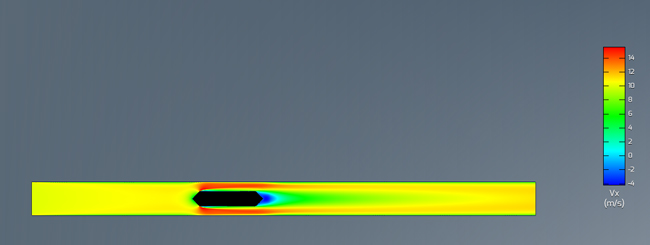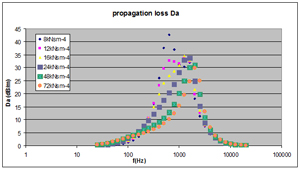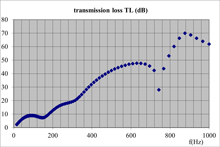The acoustic and aeraulic performance of silencers is a double problem with respect to which technological compromises (sometimes: sophisticated) must often be found in the perspective of the definition of soundproofing equipment allowing the normal operation of a network of fluid, especially when high speeds are involved.
Acoustic performance of silencers
Acoustic performance of silencers can be expressed in terms of difference (with and without silencer) of overall A weighted sound pressure levels or of sound pressure levels per octave bands at specified locations (such as maximum value at 1 m from the outlet plane of the silencer, average value of an enveloping surface) - also known as insertion difference of sound pressure level - or in terms of difference of overall A-weighted sound power levels or of sound power levels per octave bands of the outlet of the silencer (or of the mouth, or of the silenced noise source) - also known as insertion loss of the silencer -.
For orders of magnitude (and with respect to a noise spectrum like "pink noise"), a level difference of up to 10 dBA can usually be obtained without special requirements, while a level difference from 10 to 20 dBA requires a standard silencer without significant by-pass, while a level difference of 20 to 30 dBA requires a standard silencer with transverse partitionning devices of the absorbing filling and a resilient mounting, and while that a level difference of 30 to 50 dB often involves high performance silencers carefully designed and installed (a higher level difference shall involve a special achievement or 2 silencers installed in series with sufficient spacing).
Acoustic performance of dissipative silencers (at room temperature: ventilation, air conditioning, various industrial processes and for engines, gas turbines or at high temperature: stacks, exhausts - for what concerns the downstream stage of the soundproofing device when it comes to thermal engines - ...) is very frequency dependent. Dissipative silencers (or: dissipation silencers) are devices allowing an attenuation of sounds on a wide frequency range ; however, their efficiency is good neither at low frequency nor at high frequency.
Its is primarily related on the one hand to the behavior of the absorbing filling (e.g. its flow resitance for service conditions which can - in particular for the temperature - differ greatly from the laboratory conditions - quasi-atmospheric - under which the measurements were carried out) given the spacing of the airways and the length of the silencer (characterized by the propagation loss) and also, in many cases (for silencers other than those with a sound-absorbing lining on the - sometimes partial - periphery of the duct) to the geometry of the splitters (characterized by the reflection loss) and also to bypass phenomena: acoustic energy transmission through the casing of the silencer as well as, if appropriate (for silencers other than with simple dissipation) through splitters themselves, and finally to noise regenerated in relation to the speed of passage of the fluid.
|
Acoustic performance of a dissipative silencer - variation of the propagation loss i.e. of the longitudinal attenuation (dB/m) as a function of the airflow resistance of the lining (results of evaluations with SILDIS® software) |
The acoustic performance of reactive silencers (for compressors, for thermal engines exhausts) is linked to the geometric singularities of the internal parts (often: these are chambers - single, double or triple - connected by perforated or non-perforated tubes with possible changes in the direction of the gas flow; each dimension has its importance) which condition the reflections of the acoustic waves - basing the efficiency -, and also to the self noise (i.e. linked to the flow, therefore in relation to the passage speed of the fluid).
|
Acoustic performance of a reactive silencer - transmission loss of a triple expansion chamber (dB) at low and medium frequency (result of a simulation with SILDIS® software) |
Aeraulic performance of silencers
Whether it concerns dissipative silencers or reactive silencers, the aeraulic performance is, as for other components of aerodynamic circuits and piping assemblies for pressurized fluids, mainly linked to sudden section changes (widening, narrowing ) and obstacles opposing the gas flow; the total pressure loss is, as always, increasing with the density of the fluid and with the square of its velocity. The thermodynamic conditions of use of the silencer have therefore, all other things being equal, their importance.
As orders of magnitude, the total pressure loss allowed for noise reduction devices of air condensers or cooling towers (even when the fans are of very large diameters e.g. above 10 m and induce colossal flow rates, especially when there are 10 units in the same facility set) are of the order magnitude of one millimeter of water gauge (i.e. 10 Pascals) when the pressure drop allowed to an exhaust silencer for very large engines (the power is counted in MW) or for high-capacity combustion turbines (the power is counted in tens or hundreds of MW and the mass flow in hundreds of kg/s) is generally around 10 mbar (i.e. 100 mm H20 or 1000 Pa).
In the specific case of dissipative silencers, an additional pressure drop (often: low, but should not always be neglected in the case of silencers without splitters i.e. with only a peripheral sound absorbing lining) is to be considered due to the friction of the fluid against the rough surfaces which constitute the sound-absorbing lining (of variable importance depending on the nature of the surface layer, the hydraulic diameter and the length of the section considered for such a linear loss).
In the specific case of reactive silencers, if necessary, an additional pressure drop is to be considered in the case where the gas flow is forced to pass through a perforated sheet (sometimes: this is the thickness of a tube e.g. for exhaust mufflers of cars, trucks, or even small machines - such a noise attenuation stage is also found in depressurization mufflers, for the expander).

Aeraulic performance of a silencer consisting of a single splitter with profiled ends - Computational Fluid Dynamics - axial velocity mapping (longitudinal section of a rectangular duct, ITS simuation result)
Determination of the acoustic and aeraulic performance of silencers
As often in the field of acoustics, the determination of the performance of silencers can be carried out by means of calculations or measurements.
The prediction of the acoustic performance of dissipative or reactive silencers can be performed by ITS with the simulation software SILDIS®:
- with Modules 1 and 1A, for dissipative silencers
- with Module 1B, for reactive silencers
For (absorption or reflection) silencer's geometries which are not those pre-programmed in the SILDIS® software, ITS human resources can carry out calculations using other means of simulation [1] [2] [3], to determine the acoustic and aeraulic performance as well.
In all contexts, the human resources of ITS, qualified in building physics, with extensive knowledge in acoustics, aeraulics-aerodynamics (measurements, calculations, design and project management) is able to determine, as acoustician specializing in this field, the performance of silencers for reliable and optimized sizing of such noise reduction equipment, for common projects (e.g. in the building sector) or for high-tech projects (e.g. in industry) , regardless of the level of expertise required.
Measurements relating to silencers can be made (for ambiant temperature, and when they are dissipative) according to NF EN SO 7235 Acoustics - Laboratory measurement procedures for ducted silencers and air-terminal units - Insertion loss, flow noise and total pressure loss; calculations with SILDIS® software or with other simualtion tools that ITS has and results of performance measurements are then perfectly comparable.
The acoustic performance of silencers, whatever they are and whatever the conditions of service, can also be evaluated on site, according to standard NF EN ISO 11820 Acoustics - Measurements on silencers in situ.
[1] FEM : Finite Element Method
[2] BEM : Boundary Element Method
[3] CFD : Computational Fluid Dynamics (Mechanics)

